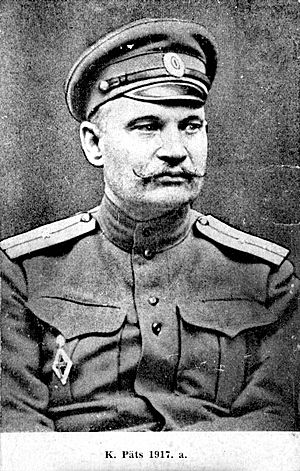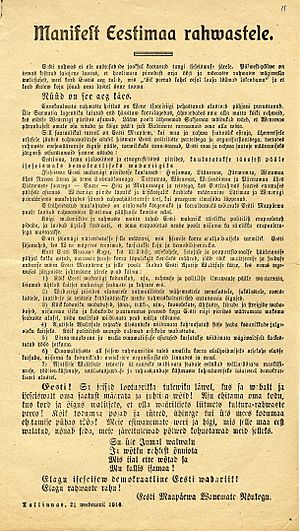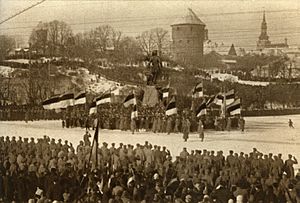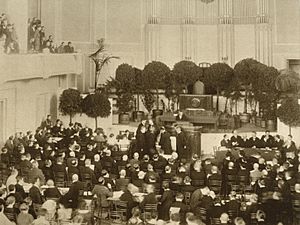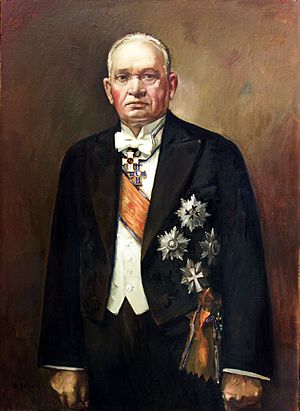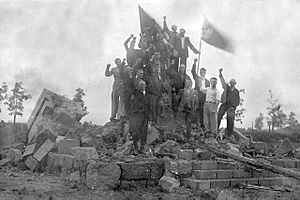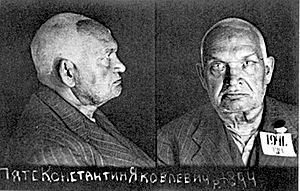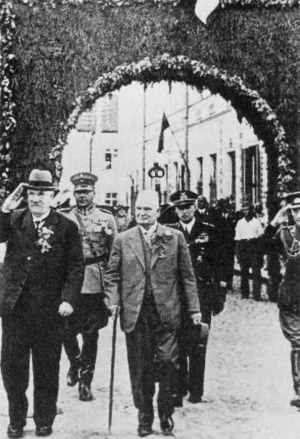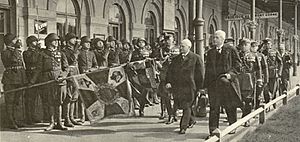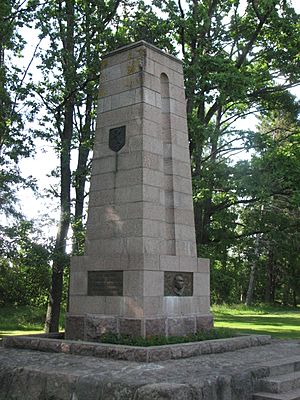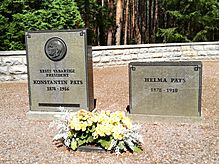Konstantin Päts facts for kids
Quick facts for kids
Konstantin Päts
|
|
|---|---|
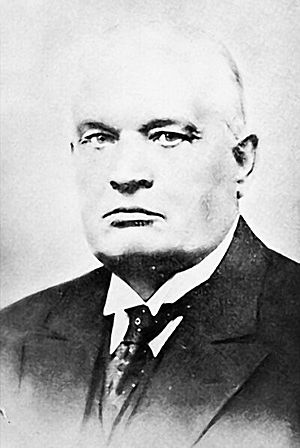
Päts in 1934
|
|
| (1st) President of Estonia | |
| In office 24 April 1938 – 23 July 1940 |
|
| Prime Minister | Kaarel Eenpalu as Acting Prime Minister Kaarel Eenpalu Jüri Uluots Johannes Vares |
| Succeeded by | Jüri Uluots as Prime Minister in duties of the President in Exile Lennart Meri as President after restoration of independence Johannes Vares as Prime Minister in duties of the President (during the Soviet occupation) |
| Chairman of the Council of Ministers of the Provisional Government of Estonia |
|
| In office 24 February 1918 – 12 November 1918 |
|
| Preceded by | Independence declared, position established |
| Succeeded by | himself as Prime Minister of the Provisional Government |
| Prime Minister of the Provisional Government of Estonia | |
| In office 12 November 1918 – 8 May 1919 |
|
| Preceded by | himself as Chairman of the Council of Ministers of the Provisional Government |
| Succeeded by | Otto August Strandmann as Prime Minister |
| 2nd, 4th, 11th, 14th and 16th State Elder of Estonia |
|
| In office 25 January 1921 – 21 November 1922 |
|
| Preceded by | Ants Piip |
| Succeeded by | Juhan Kukk |
| In office 2 August 1923 – 26 March 1924 |
|
| Preceded by | Juhan Kukk |
| Succeeded by | Friedrich Karl Akel |
| In office 12 February 1931 – 19 February 1932 |
|
| Preceded by | Otto Strandman |
| Succeeded by | Jaan Teemant |
| In office 1 November 1932 – 18 May 1933 |
|
| Preceded by | Karl August Einbund |
| Succeeded by | Jaan Tõnisson |
| In office 21 October 1933 – 24 January 1934 |
|
| Preceded by | Jaan Tõnisson |
| Succeeded by | himself as Prime Minister in duties of the State Elder |
| 6th Prime Minister of Estonia, in duties of the State Elder of Estonia |
|
| In office 24 January 1934 – 3 September 1937 |
|
| Preceded by | himself as State Elder |
| Succeeded by | himself as President-Regent |
| President-Regent of Estonia | |
| In office 3 September 1937 – 9 May 1938 |
|
| Preceded by | himself as Prime Minister in duties of the State Elder |
| Succeeded by | himself as President Kaarel Eenpalu as Prime Minister |
| Personal details | |
| Born | 23 February 1874 Tahkuranna Parish, Governorate of Livonia, Russian Empire |
| Died | 18 January 1956 (aged 81) Burashevo, Kalininsky District, Kalinin Oblast, Russian SFSR, Soviet Union |
| Nationality | Estonian |
| Political party | Country People's Union (1917–1920) Farmers' Assemblies (1920–1932) Union of Settlers and Smallholders (1932–1935) |
| Spouse | Wilhelmine ("Helma") Ida Emilie Päts |
| Children | Leo Viktor |
| Alma mater | University of Tartu |
| Profession | Lawyer, journalist, politician |
| Signature |  |
Konstantin Päts (23 February [O.S. 11 February] 1874 – 18 January 1956) was an important Estonian leader. He served as the country's first president from 1938 to 1940. Before that, he was prime minister five times in the two decades before World War II. Päts was a key figure in Estonia's journey to independence.
He faced serious charges during the Russian Revolution of 1905 but escaped abroad. He later returned and even spent time in prison. After the February Revolution in 1917, Päts led the government of the new Autonomous Governorate of Estonia. In February 1918, he helped create the Estonian Declaration of Independence. He then led the Estonian Provisional Government and helped organize the military during the Estonian War of Independence.
In the 1920s and early 1930s, Päts led a conservative political party. He was also the Speaker of the Parliament and served five times as State Elder. This role was similar to a president in Estonia's system. In 1934, he took strong action to control a powerful right-wing group called the Vaps Movement. This period, known as the "Era of Silence" (1934–1938), saw many reforms and economic growth.
In 1938, a new constitution was adopted, and Päts became Estonia's first President. However, in June 1940, the Soviet Union invaded and occupied Estonia. President Päts was forced to sign many orders from the new Soviet government. He was later arrested and sent to the USSR, where he died in 1956.
Contents
Konstantin Päts's Family Life
Konstantin Päts's parents came from Holstre in Livonia. The family name "Päts" means "loaf of bread" in Estonian. It is believed to come from his ancestors who gave out free bread from their mill during a famine.
His father, Jakob Päts (1842–1909), was a housebuilder. His mother, Olga Päts (1847–1914), was an orphan raised by a wealthy Russian family. Jakob and Olga met while working for the Krüdener family.
Konstantin had an older brother, Nikolai (1871–1940), and three younger brothers: Paul (1876–1881), Voldemar (1878–1958), and Peeter (1880–1942). He also had a younger sister, Marianne (1888–1947). Since their mother was raised in a Russian family, their father Jakob became an Orthodox Christian. All the children grew up with strong Orthodox traditions.
The family first lived in Viljandi. Konstantin's father, Jakob, was an Estonian farmer who wanted to reduce the power of German landowners. Because of this, he had to move his family to Tahkuranna in 1873. Later, they moved to Pärnu and built a new home. Jakob divided his land, and this area eventually became a part of Pärnu.
Early Life and Education
Konstantin Päts was born on 23 February [O.S. 11 February] 1874 near Tahkuranna. He was baptized in the local Orthodox church.
He started his schooling at the Orthodox parish school in Tahkuranna. In Pärnu, he attended the Russian-language Orthodox parish school. From 1887 to 1892, he studied at the Riga Clerical Seminar. He decided not to become a priest and instead went to high school in Pärnu.
From 1894 to 1898, he studied law at Tartu University and became a lawyer. After graduating, Päts served in the Russian army in Pskov. In 1900, he moved to Tallinn to begin a career in politics.
Konstantin Päts's Career
Starting in Journalism
In Tallinn, Konstantin Päts first worked as a lawyer's assistant. But he soon wanted to start his own newspaper. He got help from writers who couldn't get a license for their own paper.
Päts was able to get a license because authorities thought his newspaper would be loyal to the Russian Empire. However, his newspaper, Teataja ("The Gazette"), had strong political ideas. The first issue came out on 23 October [O.S. 10 October] 1901. This started a rivalry between Päts and another important Estonian leader, Jaan Tõnisson. Teataja focused on the importance of education and business for the Estonian people.
Early Political Steps
Päts's first goal in politics was to gain power in towns where Baltic Germans still controlled local governments. He became a city council member in Tallinn in 1904. In April 1905, he became the deputy mayor. His work in the city government left him little time for his newspaper. Revolutionaries took control of Teataja and published articles against the government.
During the Russian Revolution of 1905, Päts supported the idea of self-rule for Estonia. His newspaper was closed, and its staff were arrested. Päts managed to escape to Switzerland and later to Finland. He learned that he faced serious charges in the Russian Empire.
In Finland, he continued writing. In 1908, he moved to Ollila, near the Russian border, and became an editor for an Estonian newspaper. He was reunited with his family there.
When his wife became ill, Päts learned he could return to Russia without facing the death penalty. He moved back to Estonia in 1909. From February 1910, he was imprisoned in Kresty Prison in Saint Petersburg. His wife died of tuberculosis during this time. Päts was released on 25 March 1911. He was not allowed to live in certain parts of Estonia for six years. But with help, he returned and started another newspaper.
From 1916, Päts served as an officer in Tallinn. He worked to form Estonian military units within the Russian army. He also helped Estonians and liberal German landowners work together.
1917–1918: Self-Rule and German Occupation
In 1917, as German forces moved towards Estonia, Päts avoided military service. After the February Revolution, Estonians wanted more self-rule within the Russian Empire. Päts supported forming one self-governing area in Estonia. After protests, the autonomous Governorate of Estonia was created on 12 April [O.S. 30 March] 1917.
Päts joined the Estonian Provincial Assembly (Maapäev). He became a leading figure in the Estonian Country People's Union. He became chairman of the provincial government on 25 October [O.S. 12 October] 1917. When the Bolsheviks took control in Estonia, the Provincial Assembly was dissolved, and Päts went into hiding.
Because Bolshevik rule was weak, the Maapäev declared itself the only legal authority on 28 November [O.S. 15 November] 1917. A three-member Estonian Salvation Committee was formed on 19 February 1918, and Konstantin Päts was one of its members.
As Russian forces left and German forces advanced, the Salvation Committee declared Estonia's independence. The Estonian Declaration of Independence was issued on 24 February 1918. The Estonian Provisional Government was immediately formed, with Konstantin Päts as its leader.
On 25 February 1918, German forces captured Tallinn. Konstantin Päts was arrested on 16 June 1918 and sent to prison camps. He was released on 17 November 1918, after the war ended.
Päts's government took office again on 12 November 1918. On 27 November 1918, he became Prime Minister and Minister of War, responsible for organizing Estonia's defense.
1918–1920: War of Independence
On 28 November 1918, the Soviet Russian Red Army invaded Estonia, starting the Estonian War of Independence. By January 1919, Estonians had pushed back the Bolsheviks. By 24 February 1919, the provisional government controlled all of Estonia. Päts spoke at the Independence Day parade, emphasizing the need for a strong economy.
In April 1919, the Estonian Constituent Assembly was elected. Päts's party won only 8 of 120 seats. On 9 May 1919, Otto August Strandman became the first Prime Minister. After the war with Soviet Russia ended in February 1920, the assembly passed a land reform law and the first constitution. This led to many small parties in parliament and frequent government changes.
1918–1940: Independent Republic of Estonia
In September 1919, Päts formed a new party, the Farmers' Assemblies. In the 1920 elections, his party won 21 seats. From 1921 to 1922, Konstantin Päts was the State Elder and led the first government under the new constitution. His government fell when a centrist party left the coalition. After this, Päts served as Speaker of the Riigikogu (parliament) from 1922 to 1923.
In the 1923 elections, his party won 23 seats. On 2 August 1923, Päts became State Elder for the second time. This government also lasted less than a year. Päts stayed out of government for seven years but his party remained strong.
In the 1929 elections, Farmers' Assemblies won 24 seats. Päts served his third term as State Elder from 1931 to 1932. He led a broad coalition government. In 1932, his party merged with another to form the Union of Settlers and Smallholders.
In the 1932 elections, the new Union of Settlers and Smallholders won 42 seats. Päts became State Elder for the fourth time in November 1932. His government had to resign in May 1933.
The lack of stable governments led to new constitution proposals. A proposal by the right-wing Vaps Movement was accepted in a vote in October 1933. Päts was elected to lead a temporary government. The new constitution gave a lot of power to the head of state and reduced the parliament's role.
Päts and other leaders tried to control the Vaps Movement, which was seen as a threat. On 27 February 1934, Päts made a law that stopped military members from being involved in politics. This weakened the Vaps Movement.
Päts was a candidate for president in April 1934. But other candidates, including from the Vaps Movement, seemed more popular. There were also rumors of a coup by the Vaps Movement. On 12 March 1934, Päts took strong action to prevent this. He was supported by General Johan Laidoner and the army.
A state of emergency was declared, and the Vaps Movement was shut down. About 400 of its members were arrested. Päts postponed the presidential elections. He extended the state of emergency several times.
In February 1935, the Patriotic League was formed to replace political parties. All other political groups were suspended. Päts believed that political groups should unite society, not divide it.
In December 1935, a plot by the Vaps Movement was uncovered. More than 750 people were arrested, ending the movement. Its leaders were sentenced to forced labor but were pardoned two years later.
Meanwhile, Jaan Tõnisson criticized Päts for not bringing a new constitution into effect sooner. Other former leaders also demanded a return to democracy. Student protests also occurred.
During the emergency, Päts was able to pass many reforms. The economy grew, and infrastructure, industry, and education improved. He also supported the Estonianization of names.
Päts believed the 1934 constitution was too strict. He organized a new constitution through a public vote and a special assembly. This new constitution was approved in 1936.
On 28 July 1937, the assembly adopted the third constitution. This new constitution created a two-chamber parliament. On 3 September 1937, Päts became President-Regent during a transition period.
On 1 January 1938, the new constitution came into force. In the 1938 parliamentary elections, Päts's supporters won most seats. On 23 April 1938, Konstantin Päts was elected as the first President of Estonia. He took his oath on 24 April 1938.
On 9 May 1938, Päts appointed Kaarel Eenpalu as Prime Minister. All political prisoners were given amnesty. This period from 1934 to 1940 is often called the "Päts Era."
1939–1940: World War II and Soviet Invasion
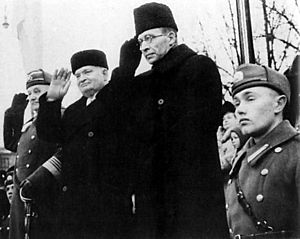
When World War II began, Estonia declared neutrality. But on 28 September 1939, Estonia was forced to sign a treaty with the Soviet Union. This allowed Soviet military bases and troops in Estonia. On 12 October 1939, Päts appointed Jüri Uluots as the new Prime Minister.
In May 1940, Päts believed Estonia should follow Soviet guidelines. However, on 16 June 1940, the Soviet Union gave an ultimatum to Estonia. The Estonian government had to accept, and a full Soviet invasion followed on 17 June 1940.
The Soviets allowed Päts to stay in office for a short time. But on 21 June 1940, he was forced to appoint a new pro-Soviet government led by Johannes Vares. Päts became a puppet leader. Over the next month, he signed nearly 200 orders from the new Soviet regime. He even signed an unconstitutional order to change election laws. On 23 June 1940, Päts said, "the greatest thing we have accomplished is the creation of the Estonian state." From 29 June 1940, Päts was under house arrest. On 21 July 1940, the new parliament declared Estonia a "Soviet Socialist Republic."
Deportation and Imprisonment
On 21 July 1940, Päts tried to get asylum in the United States for his family. The US agreed, but it was too late. On 30 July 1940, Konstantin Päts, his son Viktor, Viktor's wife Helgi-Alice, and their sons Matti and Henn were sent to Ufa, Russia. They lived there under watch for a year.
In Ufa, Päts wrote his memories and asked for his grandsons and their mother to be sent to Switzerland or Italy. He even asked to be exchanged for a German political prisoner.
On 26 June 1941, Konstantin and Viktor were arrested and imprisoned in Ufa. The children were sent to an orphanage. Päts was questioned for hours but did not admit guilt. He and his son were later sent to Butyrka prison in Moscow. Helgi-Alice was sent to prison camps in Siberia.
In 1943, Päts was sent to special hospitals for treatment. This was because he kept saying he was the President of Estonia. In 1952, he was found guilty of anti-Soviet actions. His forced treatment ended in 1954, and he was sent to a hospital in Estonia. But because people recognized him, he was moved to a hospital in Russia, where he died on 18 January 1956.
Other Activities and Honors
Between 1919 and 1933, Päts was chairman of an insurance company. He also led the Chamber of Commerce and Industry and was involved with the Harju Bank.
Päts helped found the Estonian Sports Association Kalev in 1901. He was also chairman of the Estonian-Finnish-Hungarian Association.
He received honorary doctorates from several universities, including Tartu University in 1928. He also became an honorary member of the Learned Estonian Society and the Estonian Academy of Sciences. He was named an honorary citizen of Tallinn, Narva, Pärnu, Tartu, and his home parish of Tahkuranna.
Estonia's Foreign Relations
In 1918, Päts suggested that Estonia and Finland could form a union. Finland's leaders were not interested. Päts still thought about this idea, even in 1940. In 1922, he made the first official state visit from Estonia to Finland.
In 1933, Päts visited Latvia. In 1934, Estonia, Latvia, and Lithuania signed the Baltic Entente agreement. This was another attempt to bring Finland closer to Estonia. Estonian and Polish officials also visited each other's countries in the 1930s.
In the late 1930s, as the Soviet Union became more interested in the Baltic countries, Estonia tried to get closer to Germany. On 3 December 1938, Estonia officially declared its neutrality in any European conflicts.
Criticism and Legacy
Some parts of Päts's career are still debated. For example, his business dealings with Soviet Russia have been criticized. Some say he and his allies used state money for their own benefit.
Some people believe Päts "destroyed democracy" with his actions in 1934. However, many Estonians today understand that the Vaps Movement could have been a threat to democracy. His actions were also supported by the parliament.
Others argue that Päts and his allies used the 1934 events for their own gain. They point out that it took a long time to adopt a new constitution.
Päts was generally seen as a modest person. But he has been criticized for promoting himself too much. He received many state awards and was made an honorary citizen of several towns. His birthday was even celebrated as part of Estonia's Independence Day. He was also the first person in Estonia to have postage stamps with his picture.
Päts's actions during the 1940 Soviet invasion have also been questioned. Some theories suggest he was a Soviet agent or collaborator. Others believe he saw the invasion as unavoidable or was too ill to handle the situation.
Historian Magnus Ilmjärv suggests that Soviet Russia tried to influence top Estonian politicians, including Päts, through business dealings. He claims Päts was secretly pro-Russian and even suggested a federation between Estonia and the Soviet Union.
Other theories suggest Päts trusted Soviet officials or that the Soviet secret police controlled the information he received. Some historians believe Päts's actions were simply in line with Soviet demands after 1939.
Another idea is that Päts knew a war between Nazi Germany and the Soviet Union was coming. He might have tried to keep Estonians safe by avoiding conflict with the Soviets and buying time. As a lawyer, he would have known that decisions made under occupation were not truly valid.
Remembering Konstantin Päts
Konstantin Päts was quite successful in Estonian politics. His party was part of most governments between 1921 and 1933. He himself served as State Elder four times.
He was only unofficially the chairman of the Farmers' Assemblies party. He often disagreed with his own party members.
Päts was a member of parliament for many years:
- 1917–1919 Estonian Provincial Assembly (Maapäev)
- 1919–1920 Estonian Constituent Assembly
- 1920–1923 I Riigikogu
- 1923–1926 II Riigikogu
- 1926–1929 III Riigikogu
- 1929–1932 IV Riigikogu
- 1932–1934/1937 V Riigikogu
Päts's political ideas changed over time. Early on, he was seen as a socialist. Later, he became more of a social liberal. By the time Estonia became independent, he was a conservative. During his authoritarian years, he showed influences of statism.
According to international law, Päts remained the legal President until his death in 1956. His duties were passed to the last pre-occupation Prime Minister, Jüri Uluots.
Many places and institutions in Estonia have been named after Konstantin Päts. A boarding school in Tallinn was opened at his suggestion for children with breathing problems. A special rose cultivar was named after him.
A museum about Konstantin Päts was opened in 1991 in the Tallinn Botanical Gardens, where his old farmstead is located.
Päts has also been shown in books and TV shows. In the satirical Memoirs of Ivan Orav, he is shown as a beloved leader. In the puppet political satire show Pehmed ja karvased, he is a talking bust. His life was also shown in the TV series Tuulepealne maa.
Päts's Final Resting Place
In 1988, two Estonians, Henn Latt and Valdur Timusk, searched for Konstantin Päts's remains in Russia. They found his last doctor, who described his funeral in 1956. She said he was buried like a president. On 22 June 1990, his grave was found, and his remains were reburied in Tallinn Metsakalmistu cemetery on 21 October 1990. A memorial cross was placed in the Russian village where he was buried.
Personal Life
In 1901, Konstantin Päts married Wilhelma ("Helma") Ida Emilie Peedi. They had two sons, Leo and Viktor. Konstantin went into exile in 1905, and his second son was born while he was away. His wife died in 1910, and Päts never remarried. His wife's sister helped raise his children.
Päts was seen as a kind person who gave good speeches. He grew up in the countryside and cared about the land. He was especially interested in children's issues. He often gave money to large families and schools and organized events for students. He was known for taking walks in Kadriorg park and talking to park workers. Konstantin Päts had diabetes.
In 1919, Päts rented and later bought a farmstead outside Tallinn. He was given this farmstead for his contributions to the Estonian War of Independence. This farmstead is now part of the Tallinn Botanic Garden.
Päts's Descendants
Konstantin's oldest son, Leo Päts (1902–1988), escaped to Finland in 1939 and later moved to Sweden. Konstantin's second son, Viktor Päts (1906–1952), died in Butyrka prison in Moscow. Viktor's sons, Henn (1936–1944) and Matti (b. 1933), were sent to an orphanage in 1941. Henn died of starvation in Matti's arms in 1944.
All living descendants of Konstantin Päts are from Matti Päts. Matti returned from Russia with his mother in 1946. Matti Päts has been the director of the Estonian Patent Office since 1991. He has also been a member of the Estonian parliament and the Tallinn city council.
Awards and Honors
- 1920 – Cross of Liberty I/I
- 1920 – Cross of Liberty III/I
- 1921 – Order of the Estonian Red Cross III
- 1935 – Order of the Three Stars, 1st Class (Latvia)
- 1926 – Order of the Estonian Red Cross I/I
- 1929 – Order of the Cross of the Eagle I
- 1936 - Order of Vasa, Grand Cross (Sweden)
- 1938 – Special sash of the Order of the National Coat of Arms
- 1938 – Collar of the Order of the White Star
- 1938 – Collar of the Order of the National Coat of Arms
Images for kids
-
Estonia's leaders before the Soviet occupation, celebrating the country's Independence Day for the last time, on 24 February 1940. From left General Johan Laidoner, President Konstantin Päts and Prime Minister Jüri Uluots.
-
President of Finland Pehr Evind Svinhufvud and Konstantin Päts in Narva in 1936.
-
President Konstantin Päts visiting Polish president, Ignacy Mościcki, in 1935.
See also
 In Spanish: Konstantin Päts para niños
In Spanish: Konstantin Päts para niños



